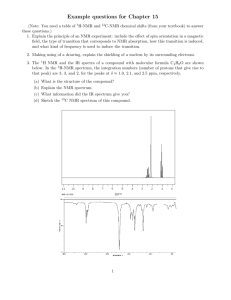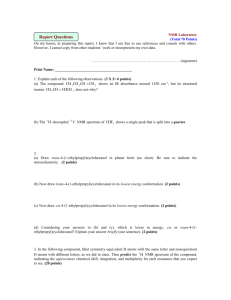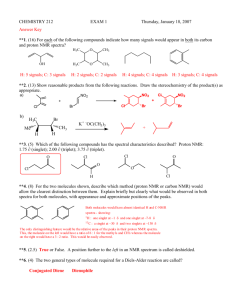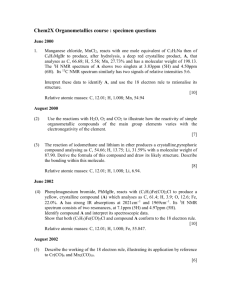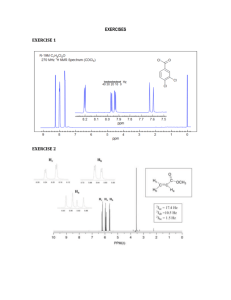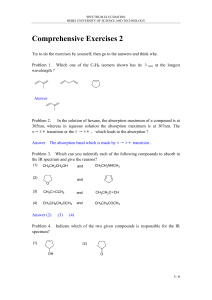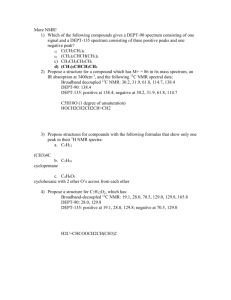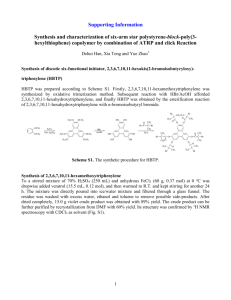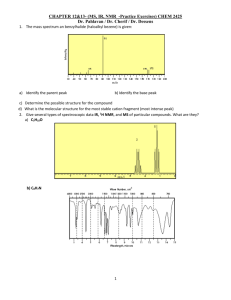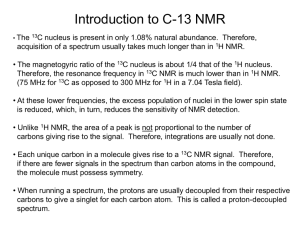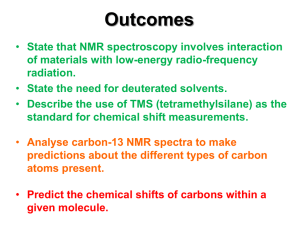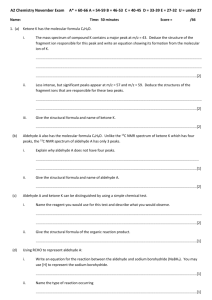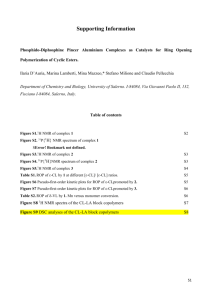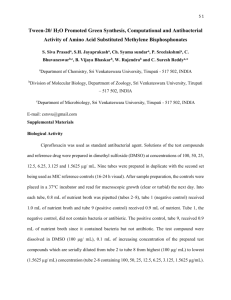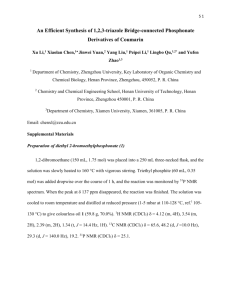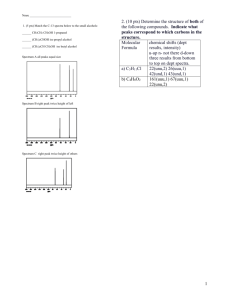Practice Exam 2 ans - University of Missouri
advertisement
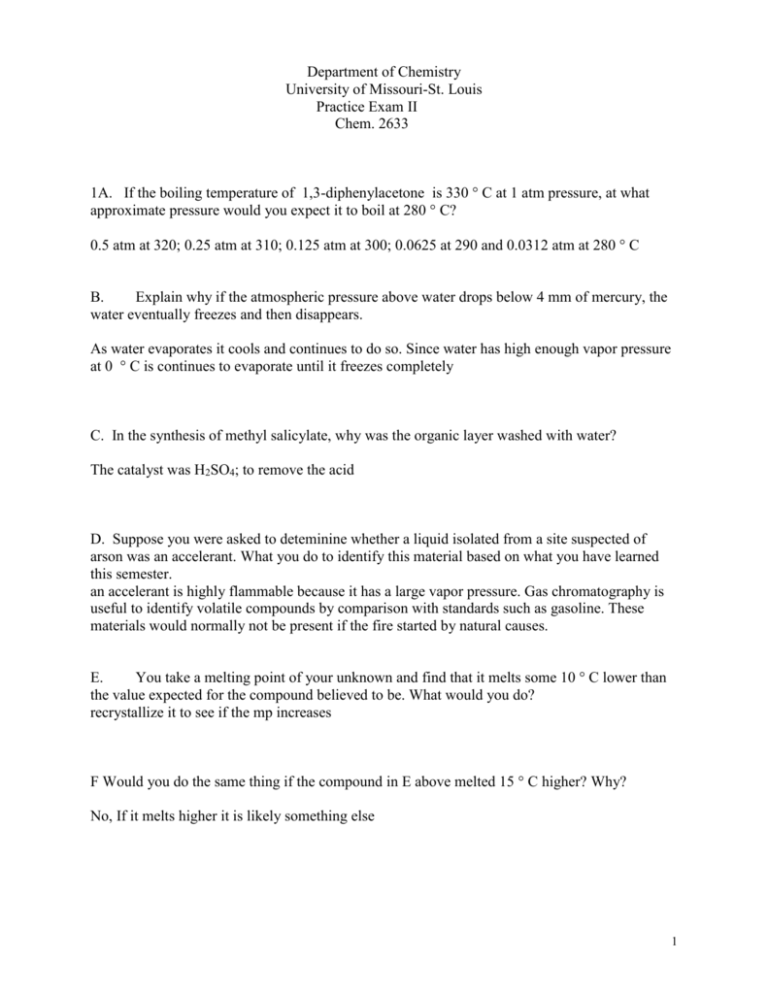
Department of Chemistry University of Missouri-St. Louis Practice Exam II Chem. 2633 1A. If the boiling temperature of 1,3-diphenylacetone is 330 ° C at 1 atm pressure, at what approximate pressure would you expect it to boil at 280 ° C? 0.5 atm at 320; 0.25 atm at 310; 0.125 atm at 300; 0.0625 at 290 and 0.0312 atm at 280 ° C B. Explain why if the atmospheric pressure above water drops below 4 mm of mercury, the water eventually freezes and then disappears. As water evaporates it cools and continues to do so. Since water has high enough vapor pressure at 0 ° C is continues to evaporate until it freezes completely C. In the synthesis of methyl salicylate, why was the organic layer washed with water? The catalyst was H2SO4; to remove the acid D. Suppose you were asked to deteminine whether a liquid isolated from a site suspected of arson was an accelerant. What you do to identify this material based on what you have learned this semester. an accelerant is highly flammable because it has a large vapor pressure. Gas chromatography is useful to identify volatile compounds by comparison with standards such as gasoline. These materials would normally not be present if the fire started by natural causes. E. You take a melting point of your unknown and find that it melts some 10 ° C lower than the value expected for the compound believed to be. What would you do? recrystallize it to see if the mp increases F Would you do the same thing if the compound in E above melted 15 ° C higher? Why? No, If it melts higher it is likely something else 1 2. A student received an unknown that had a melting point of approximately 130 °C. After looking up all the possible compounds that could be found with a similar melting point, the list of possibilities was narrowed down to the following compounds: 1,4-dinitronaphthalene; 2-amino-4-chloropyridine; 4,4'dimethoxybenzil; benzamide; 1,4,5,8-tetramethylnaphthalene; benzoin; 4-cyclohexylphenol; 2,5-dichlorobenzonitrile; NO2 Cl O O O NH2 N NO2 CH3 CH3 O NH2 OCH3 CH3O H OH Cl HO Cl CH3 CH3 C N The following solubility test was performed: the compound was not soluble in dilute acid or base; and it had the following infrared spectrum, 1 H and 13 C NMR spectra. What is the most likely structure of the unknown? Show your reasoning. c carbony group The compound has a carbonyl group but no NH2 or O-H stretching eliminating (from left to right) compounds 1,2,4,5,6,7 and 8 2 Problem 2 continued 1 H NMR The nmr has an OCH3 group and a pair of symmetric aromatic hydrogens area ratio (left to right): 2 ;2; 3 13 C NMR The 13 C NMR has C=O; likely 6 (or 12) aromatic C and OCH3; 4,4’dimethoxybenzil seems to be the only compound consistent with all the data (compound 3) 3 3. (15pts) As some of you may have have experienced, a typical problem associated with the IR spectrometer is that if you are not careful, you can print a different spectrum than your own. This happened to Iva Problem. Iva steamed distilled cinnamon and isolated cinnamaldehyde. However, when the spectrum was printed, it was not clear that the correct spectrum was printed. The spectrum obtained is given below but Iva is not sure whether this spectrum is the correct one or whether it is one of the other two spectra run by Noel Help or Kant Bebothered. Noel isolated carvone from cloves and Kant isolated eugenol from cloves. O CH3 O H O H3C carvone OH CH3 eugenol cinnamaldehyde Please help Iva solve her problem. Did she print out the correct spectrum? What compound is this a spectrum of? To help you solve this problem, the 1H and C13 NMR spectrum is included.. IR suggests a carbonyl, some unsaturation >3000 cm-1, no OH, 4 1 H NMR vinyl hydrogens at 4.8 and 6.8 ppm, CH3 groups on a double bond at 1.8 ppm. area ratio (left to right): 1; 2; 5; 3; 3 13 C NMR: carbonyl carbon, 4 vinyl C: only compound consistent with all the data is carvone 5 Typical 1H Chemical Shifts Carbon environment chemical shifts (ppm) C=O (in ketones) 205 - 220 C=O (in aldehydes) 190 - 200 C=O (in acids and esters) 170 - 185 C in aromatic rings 125 - 150 C=C (in alkenes) 115 - 140 RCH2OH 50 - 65 RCH2Cl 40 - 45 RCH2NH2 37 - 45 R3CH 25 - 35 CH3CO20 - 30 R2CH2 16 - 25 RCH3 1 6


